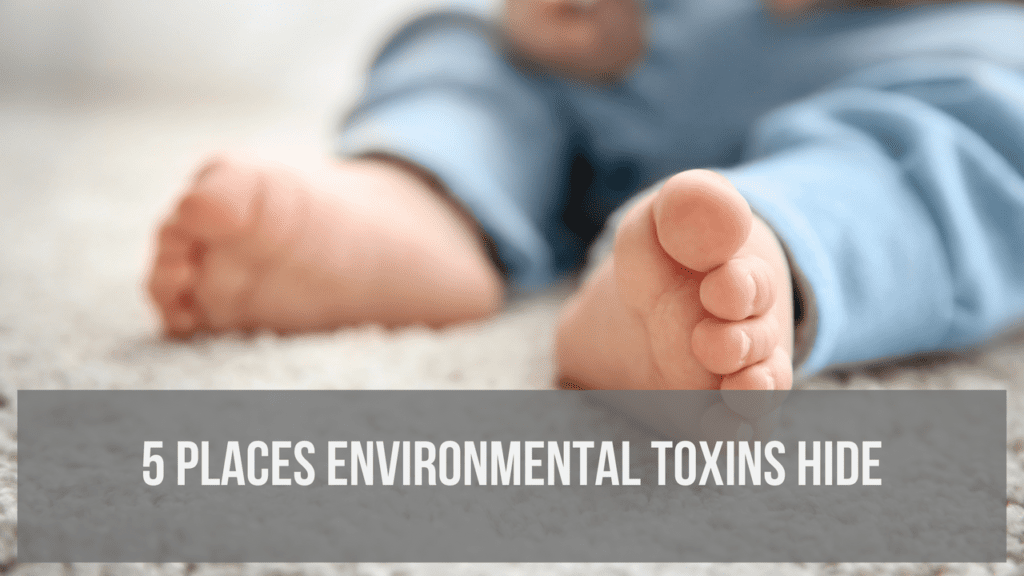Where environmental toxins hide
Did you read last week’s blog on toxins? If so…
👋 Raise your hand if you think about your child’s tic symptoms and if toxins impact them.
Did you know that everything is a chemical; water is made of chemicals, the air is made of chemicals, and yes, even you are made of chemicals. However, we’re not talking about ALL chemicals, but rather chemicals or biotoxins that cause or contribute to adverse health effects.
When it comes to disease prevention, reducing tic symptoms, and improving behavior, most people know they need to eat healthy foods and exercise. In addition, you know you should drink lots of water and get plenty of sleep.
But what about environmental toxins?
Environmental toxins lurk all around us and in products we use every day. If these exposures overwhelm our detoxification systems, they can drive disease.
According to the National Institutes of Health, only 5-10% of cancers are attributed to genetics. The remaining 90-95% is due to our environment and lifestyle. It is staggering to think that Worldwide, 100K – 150K chemicals are registered for use. Due to loopholes in the United States, our federal policy allows for a considerable amount of toxicants in our environment. In the United States, there are approximately 86,000 chemicals registered for use. This includes 62,000 chemicals grandfathered in when the Toxic Substances Control Act was passed. This means 62,000 chemicals were given a free pass and an automatic presumed safe without any studies to back that up.
So, if avoiding environmental toxins is not yet part of your wellness routine, I suggest you start now. Here are some common places where environmental toxins hide:
☠️ Carpet, upholstery, and manufactured wood can off-gas volatile organic compounds (VOCs like formaldehyde), which can be irritants or cause headaches.
☠️ Furniture, carpets, and bedding that contain flame retardants can release hormone-disrupting polybrominated diphenyl ethers (PDPEs) into the air and house dust.
☠️ Cleaning products commonly contain ammonia, synthetic fragrances, and other chemicals that can act as irritants or health disruptors.
☠️ Personal care products (rubbed directly into your skin!!) commonly contain hormone-disrupting parabens and phthalates.
☠️ Plastics and food containers often contain hormone-disrupting bisphenol A (BPA).
So, what can we do?
✅ Dust & vacuum regularly
✅ Minimize plastics use
✅ Choose non-toxic personal care products and cleaning supplies
✅ Place air purifiers in critical areas of the house, especially in bedrooms
Minimizing our exposure is vital, but we can also support our bodies in detoxifying these chemicals every day.
Toxins are one piece of the puzzle. But unfortunately, when it comes to our children’s health, we have to look at all of the puzzle pieces.
If your child’s body was a puzzle (and it is), we need to look at all the pieces. If you dump a 1,000-piece puzzle on the coffee table and only work with one piece, you never get a look at the entire picture.
It’s my job as a Tic Disorder expert to understand what is DEEPLY going on with your child and connect that back to a solution so that we can create a clear step-by-step plan for your family. I will work with you and your child to identify any potential tic disorder triggers and develop strategies to manage them. By understanding the root causes of your child’s tics, we can tailor our approach to effectively alleviate their symptoms and improve their quality of life. I am committed to providing comprehensive and personalized care for your child, and together we will navigate the challenges of living with a tic disorder.
That makes the Kick the Tics Framework a no-brainer and a big HELL YES!
Do you want to learn how our clients are eating better, pooping better, sleeping better, and seeing a massive reduction in symptoms without another doctor visit or prescription?
Are you ready for massive results?
Then, click HERE to find out exactly how my clients reduce and eliminate tic disorder symptoms naturally.
Next week, I’ll share some of my favorite foods to support detoxification. Stay tuned!

